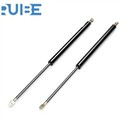(1) Talking about the diameter of the spring wire d: the diameter of the steel wire used to manufacture the spring.
(2) Spring outer diameter D: the maximum outer diameter of the spring.
(3) Spring inner diameter D1: the minimum outer diameter of the spring.
(4) Spring diameter D2: the average diameter of the spring. Their calculation formula is: D2=(D+D1)÷2=D1+d=D-d
(5) t: Except for the support ring, the axial distance between the corresponding points of the two adjacent rings of the spring on the middle diameter becomes the pitch, which is represented by t.
(6) Effective number of turns n: the number of turns the spring can keep the same pitch.
(7) Number of supporting turns n2: In order to make the spring work evenly and ensure that the axis is vertical to the end face, both ends of the spring are often tightened during manufacture. The number of tight turns only serves as a support and is called a support ring. Generally, there are 1.5T, 2T, 2.5T, and 2T is commonly used.
(8) The total number of turns n1: the sum of the effective turns and the support turns. That is, n1=n+n2.
(9) Free height H0: the height of the spring without external force. Calculated by the following formula: H0=nt+(n2-0.5)d=nt+1.5d(when n2=2)
(10) Spring unfolding length L: the length of the steel wire required for winding the spring. L≈n1(ЛD2)2+n2(compression spring) L=ЛD2n+ hook extension length (tension spring)
(11) Helix direction: there are left and right rotations, usually right-handed, right-handed if not indicated in the drawing.






